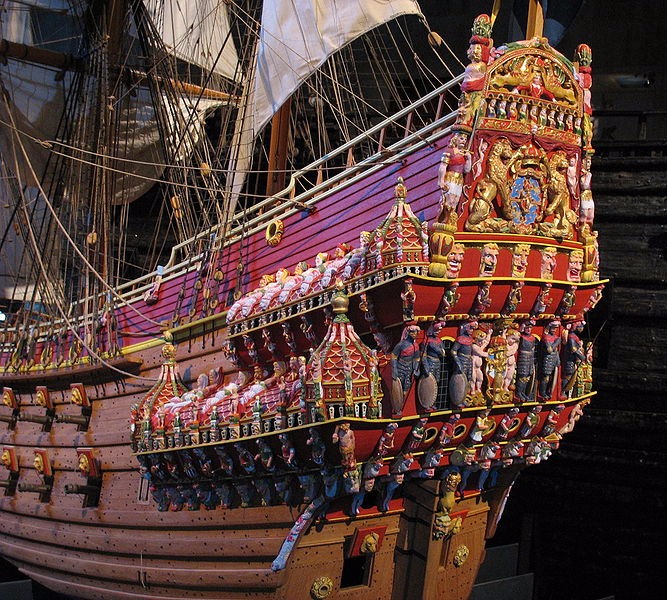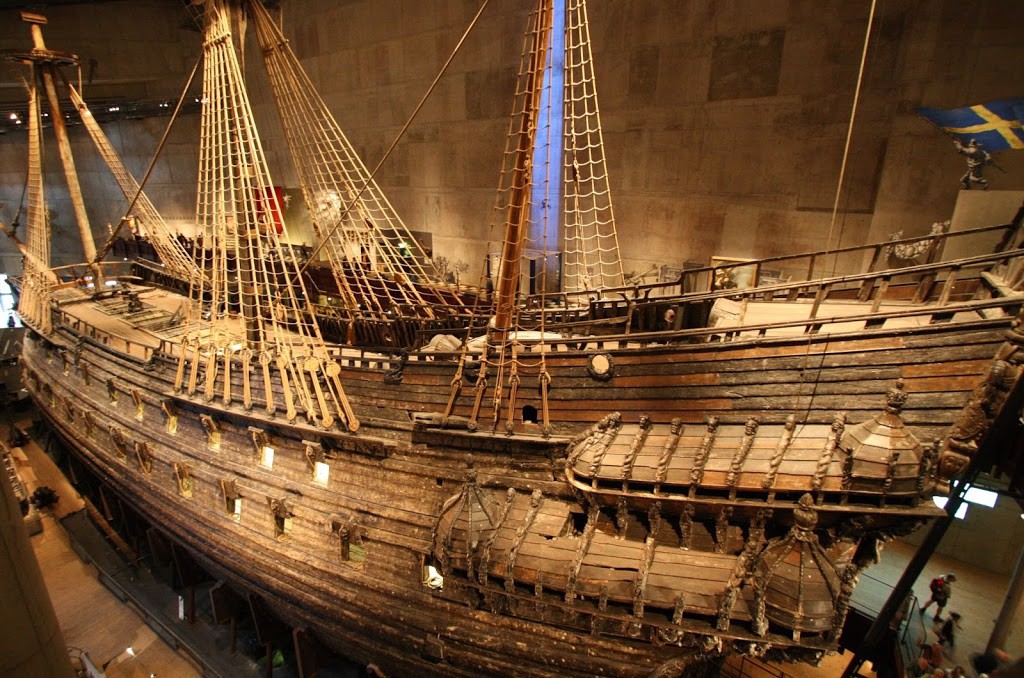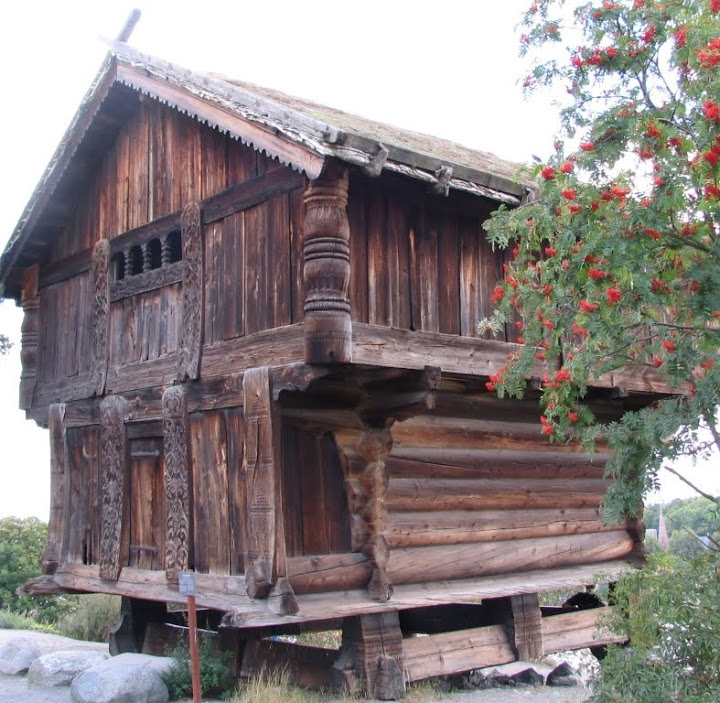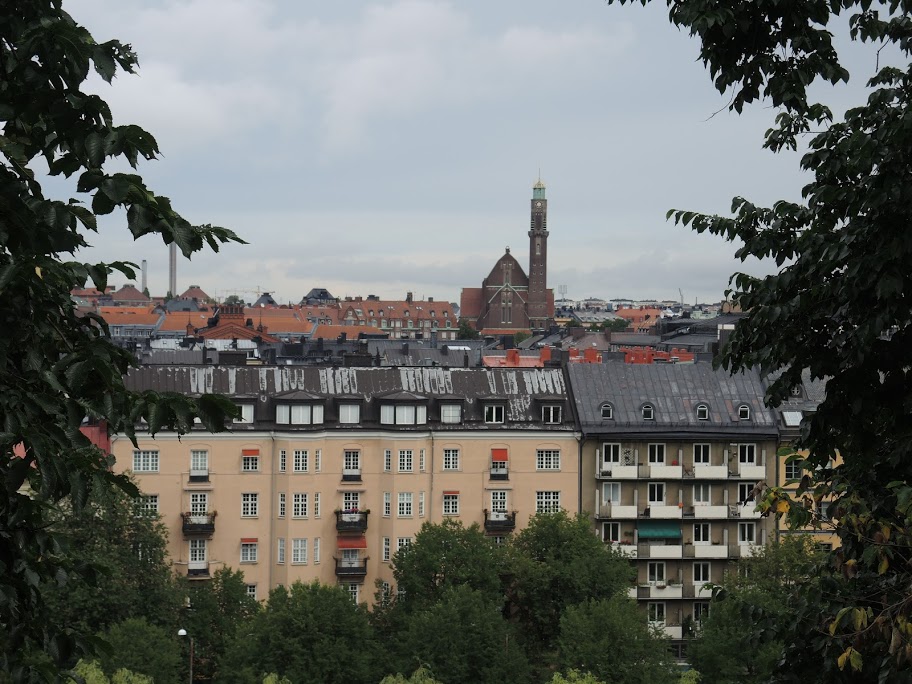In terms of area, Stockholm isn’t a very large city. At about 188 square kilometers, it’s just a tad larger than Washington, DC which measures 177 square kilometers. (For those who prefer imperial measurements, that would be about 72.5 to 68 square miles.) It is a bit more densely populated than the American capital with 5,200 people per square kilometer compared to Washington’s 3,969. In terms of cultural density, however, I’m not sure many cities compare to Sweden’s capital.
This modestly sized city of islands houses nearly 100 museums with nearly 20 on the small island of Djurgården alone. Needless to say, my days in the Swedish capital were jam packed. As with the other Nordic cities, I recount those days in greater detail in my original posts in the series Scotland and Scandinavia 2015. For this series, I’ll be more selective.
Vasa-motta U.
Our day began with the de rigueur photo op orientation bus tour that deposited us on Djurgården where my first stop was the Vasa Museum. (Though some of my youthful proclivities are probably clear, I’ll still award bonus points to the first person who gets the section header reference.) Throughout much of the 17th century, Sweden was one of Europe’s great powers and in 1626 King Gustav II Adolphus commissioned the construction of what was, up to that time, the largest warship ever built – the Vasa. A model reproduction suggests it looked like this:.
The Vasa, bearing the name of the royal family, was approximately 70 meters long and 12 meters wide. Its tallest mast reached a height of 55 meters and it was among the first warships to have two gun decks.
After nearly two years of construction and despite concerns about the ship’s stability expressed by one of his vice-admirals because it had failed the lurch test, Gustav ordered the Vasa launched on 10 August 1628. (In the lurch test 30 sailors ran across the ship from side to side. After a mere three rounds the ship rocked so violently they stopped the test to prevent the ship from heeling.)
Swedish nobility, royals from other European countries and much of the population of Stockholm ringed the harbor for the great event. The ship sailed just a few hundred meters before it began to list. Quick work by the crew managed to set it right but when the canons fired a salute, it unbalanced the ship once again. This time the crew was unable to set it aright and, with a life even briefer than the Titanic, a mere 1,300 meters into its maiden voyage, Vasa sank to the bottom of Stockholm’s harbor where it sat for more than three centuries before it was raised to the surface.
Much of the museum was constructed around the ship and here is the Vasa as it looked in 2015 when I took this photograph.
Let’s call the whole thing off.
I walked a few hundred meters from the Vasa Museum to Abba the Museum. I’m a big Abba fan (Who isn’t?) and had tried to purchase an entry the previous night but the reservation system continually rejected my credit card. I made this walk hoping for a second chance but the queue outside was too intimidating so I headed across the Djurgården to Skansen. (And if anyone makes the very obscure connection between this section’s heading and the original post, I might have to send you a prize.)
Skansen is an open-air museum established 1891 by Artur Hazelius. Hazelius’ goal was preserving elements of Swedish rural life so he transported complete farms from both the Skåne region in the south and from a Sami camp in the north. Skansen also has cultivated plots, gardens, and both domestic and wild animals.
In fact, some 75 different species and breeds of Scandinavian animals are represented there and you can see traditional breeds of cows, pigs, horses, sheep and goats, geese, hens, ducks, and reindeer. There’s also a zoo populated with wild animals such as brown bears, wolves, seals, lynx, wolverines, and elk.
Skansen is very much a living museum and its focus remains Swedish rural life. In fact, in the years since Hazelius died in 1901, some 150 houses and farmsteads have been moved there. The oldest building though is the only non-Swedish building,
the Vastveit Storehouse which dates from 14th century Norway. The legitimacy of its presence is drawn from the union between Sweden and Norway that lasted until 1905.
My first full day in Stockholm ended with dinner at a restaurant called De Svarta Fåren on the opposite side of Stortorget – the oldest public square in Stockholm. I chose to sit outside on the square. The dinner was fine – a seafood stew accompanied by a half liter of Paulaner Hefe Weissbier – but that was made memorable first by a massive rain storm that overflowed the awning and forced some of the diners (but not me) to move inside. And second by a rather bizarre conversation I had with a couple of heavily tattooed guys who fortunately love Americans and are tolerant of the Finns but pretty much disrespected everyone else – particularly Germans, Russians, and Danes – with heavily expletive laden language. I think they were saying this in fun and for the shock value.
A good wander with a high point but no cemetery visit.
I spent much of the next day wandering about the city. In the morning I stopped at the Dance Museum (Dansmuseet) – the brainchild of Rolf de Maré. It’s an outgrowth of the International Archives for the Dance, the museum he founded in Paris in 1933 and which was the world’s first museum solely devoted to dance. In addition to artifacts from his own company the Ballets Suédois, the Dance Museum has a large collection from Sergei Diaghilev’s Ballet Russes considered by many as the most influential ballet company of the 20th century.
The rest of the day was almost a pure wander. I deliberately walked to the Opera House and the Concert Hall where all Nobel Laureates, excepting the Peace Prize recipient, receive their award before I set out on Drottninggattan – the longest pedestrian street in Stockholm. This eventually led me to a green and rather steep hill the Observatorielunden.
I crested the hill after exchanging greetings with three off leash but very friendly dogs and found myself facing the Old Stockholm Observatory which maintains the oldest continuous daily temperature record in the world dating back to 1756. I was admiring a view of the part of the city called Vasastaden or Vasastan
when I was approached by an Asian fellow who excitedly told me that according to his Siri, Observatory Hill is the highest point in Stockholm. I thanked him for the information and after a few minutes headed back to the hotel to prepare for the overnight ferry to Helsinki.
If you’re wondering why I didn’t visit the Norra begravningsplatsen or “The Northern Cemetery” where I could have found the graves of the likes of August Strindberg, Ulrich Salchow, Alfred Nobel, and Ingrid Bergman, the answer is simply time and logistics. The cemetery is in the suburban town of Solna and while it’s only about five kilometers from Stortorget, I feared with my limited time, it was too far to walk and too risky to chance not being able to find a cab for the return trip if I needed one.
Be assured that Abba the Museum and the Northern Cemetery will be on my itinerary should I ever again visit Sweden’s beautiful capital city.



